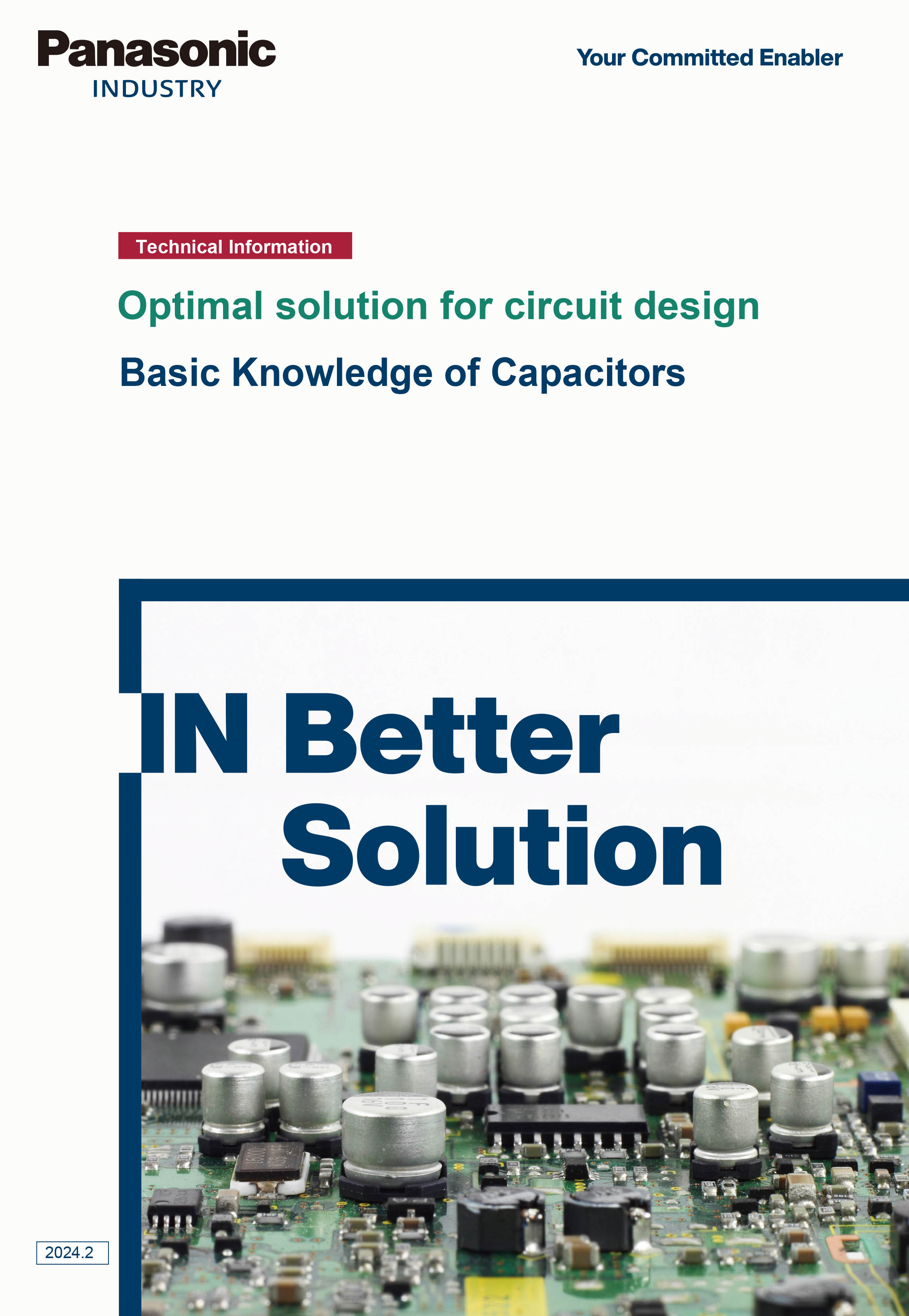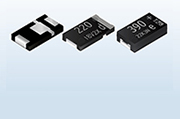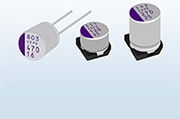Basic Knowledge of Capacitors(2)
-Types, Characteristics, Applications-
2018-06-26
The previous article introduced capacitors' principles, structure, use methods, characteristics, classification, etc.
In the following issue, we will introduce different types of capacitors and their features, applications, etc.
Types of Capacitors
There are a variety of capacitors depending on the materials used, structures, etc. Capacitors' features differ depending on their types, which are selected in the design phase based on these features. The diagram below shows the major types of capacitors.
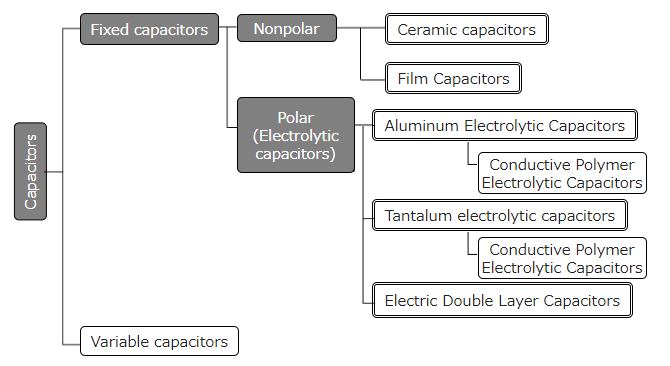
Variable Capacitors
Although fixed capacitors are mainstream, there are also variable capacitors, whose capacitance can be changed within a specific range.
The capacitance of variable capacitors is usually altered by changing the area of opposing electrodes.
Variable capacitors include tuning capacitors, which are frequently changed such as for radio tuning purposes, and trimmer capacitors that are changed only once for adjustment during circuit assembly.
Their capacitance is changed with a knob or a driver. This structure for mechanically changing the capacitance makes it difficult to produce capacitors with a large capacitance. As a result, variable capacitors have a small capacitance at the pF (picofarad) level.
Nonpolar and Polar Capacitors
Fixed capacitors are broadly classified into the nonpolar and polar types.
Nonpolar capacitors have no restrictions on the polarity of the voltage applied to their terminals. In other words, either terminal can be positive. Nonpolar capacitors can be directly used in AC circuits because a voltage that rises or falls from a zero potential can be applied.
Ceramic and film capacitors are major types of nonpolar capacitors, as well as mica, paper, and air capacitors.
On the other hand, the positive terminal of polar capacitors is predetermined, and erroneous use causes a capacitor failure. Therefore, polar capacitors have a restriction whereby they have to be used with a DC voltage or a voltage that varies only on the positive side. However, polar capacitors are widely used due to their advantage of being able to more easily provide small and large capacity capacitors. Aluminum electrolytic capacitors, tantalum electrolytic capacitors, conductive polymer (electrolytic) capacitors, and electric double layer capacitors fall into this category.
Ceramic Capacitors
Ceramic capacitors, which use ceramic with a high permittivity as their dielectric, have the following features.
- Non polar
- Excellent high frequency characteristics (low ESR)
- High heat resistance
- Long life
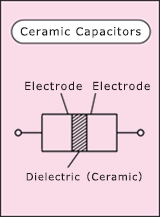
Ceramic capacitors were originally single-plate capacitors with a high withstand voltage and small capacity. However, their application range has significantly expanded with the emergence of multilayer ceramic capacitors that have achieved miniaturization and large capacitance through their thin-film multilayer structure, and of ceramic capacitors for temperature compensation that have overcome inferior temperature characteristics (high change rate of capacitance due to temperature). Ceramic capacitors are now the most commonly used capacitors. It should be noted that because ceramic capacitors for temperature compensation are larger than conventional high permittivity capacitors and for which it is difficult to have a large capacity, their use depends on applications.
Ceramic capacitors also have disadvantages that require attention when used, such as DC bias characteristics (significant change in capacitance depending on the applied voltage), squealing (occurrence of noise due to high frequency vibration), and cracks that are likely to occur due to temperature or mechanical impact.
Film Capacitors
Film capacitors, which use a plastic film as their dielectric, have the following features.
- Non polar
- Excellent high frequency characteristics (low ESR)
- Excellent temperature characteristics (small rate of change in capacitance due to temperature)
- Compatible with highly accurate capacitance
- Long life
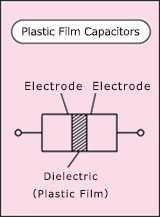
Although film capacitors have lower heat resistance compared to ceramic capacitors, they have additional features such as excellent temperature characteristics and compatibility with highly accurate capacitance. Furthermore, film capacitors have no issues with DC bias characteristics, squealing, or cracks due to temperature or mechanical impact. With these advantages, film capacitors can achieve a higher performance than ceramic capacitors. However, film capacitors have disadvantages such as their large size and high price and are therefore used in voltage/capacity ranges that cannot be covered by ceramic capacitors and for high performance and high accuracy applications.
Film capacitors have different features as shown below depending on the dielectric used, and different types are used in accordance with applications.
| item | PET Polyethylene terephthalate |
PP Polypropylene |
PPS Polyphenylene sulfide |
PEN Polyethylene naphthalate |
|---|---|---|---|---|
| Film unit price | ◎ | 〇 | × | △ |
| Miniaturization | ◎ | △ | 〇 | ◎ |
| Heat resistance | 〇 | △ | ◎ | ◎ |
| Moisture resistance | △ | ◎ | 〇 | △ |
| tanδ(ESR) | 〇 | ◎ | ◎ | 〇 |
| Target use |
|
|
|
|
PET and PP are lead wire type dielectrics, and previously, PET, which is small and low-priced, was designed for general use, whereas PP with its excellent high frequency characteristics (low ESR) was used for high frequencies and large currents. However, with the progress in the miniaturization technology of PP film capacitors, PP, which also features high safety and high moisture resistance, is used more commonly now.
PPS and PEN, which feature high heat resistance, are used in surface mount type film capacitors. In terms of electric characteristics, PEN is close to PET, whereas PPS is close to PP.
Aluminum Electrolytic Capacitors
Aluminum electrolytic capacitors have a structure in which an aluminum oxide film, which becomes a dielectric, is formed on the surface of the aluminum foil of the anode, and electrolyte liquid (consisting of a solvent in which electrolyte is dissolved) is used as an electrolyte (cathode).
One feature of aluminum electrolytic capacitors is their large capacity, which is achieved by increasing the electrode surface area (S) through the etching of the aluminum foil surface to form irregularities and by forming ultra-thin (d) of oxide films at the Angstrom level.
However, their equivalent series resistance (ESR) is higher than that of ceramic and film capacitors.
Aluminum electrolytic capacitors are products with a limited life. The electrolyte liquid vaporizes depending on the temperature and gradually penetrates the sealing rubber. Consequently, the capacity decreases and ESR rises over time, eventually leading it to be in an open state (electrolyte liquid having dried up).
When estimating the life of aluminum electrolytic capacitors, the "10ºC 2-fold law" can usually be applied.
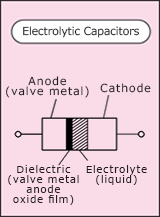

Tantalum Electrolytic Capacitors
The basic structure of tantalum electrolytic capacitors is almost identical to that of aluminum electrolytic capacitors. On the surface of sintered tantalum metal powder, which will become an anode, tantalum pentoxide is formed as a dielectric, and manganese dioxide (solid) is used as electrolyte.
Tantalum electrolytic capacitors are smaller than aluminum electrolytic capacitors and feature excellent frequency characteristics and a long life (solid electrolyte).
On the other hand, safety measures are required since they have a short-circuit failure mode, which raises the risk of ignition.
Conductive Polymer Electrolytic Capacitors
Conductive polymer electrolytic capacitors use conductive polymer (solid) as an electrolyte.
Because conductive polymer has a very high electric conductivity, i.e., 10,000 times that of electrolyte liquid of aluminum electrolytic capacitors and 1,000 times that of manganese dioxide of tantalum electrolytic capacitors, and has a very low equivalent series resistance (ESR), conductive polymer electrolytic capacitors are better suited to ripple absorption applications than other electrolytic capacitors.
As a result, more conductive polymer electrolytic capacitors are used as replacements for other types of electrolytic capacitors. However, because they are expensive and none of them come with a high rated voltage, conductive polymer electrolytic capacitors and other types of electrolytic capacitors are used differently in accordance with the applications.
Electric Double Layer Capacitors
Electric double layer capacitors are special capacitors whose capacity is between that of aluminum electrolytic capacitors and secondary batteries, and their capacity density is approx. 1,000 times or greater than that of aluminum electrolytic capacitors and approx. 1/10 that of secondary batteries.。
Electric double layer capacitors do not have a dielectric like electrolytic capacitors. Instead, they use an electric double layer formed at the interface between the electrode and electrolyte liquid as a dielectric function. This is where the name "electric double layer capacitors" came from.
The charge and discharge process of electric double layer capacitors uses ionic adsorption and desorption on the surface of activated carbon electrodes, which are used as positive and negative electrodes. The diagram below shows how the double layer changes due to this charge and discharge process.

Electric double layer capacitors have the following features in comparison with secondary batteries.
- The number of charge/discharge cycles has little impact on the degradation of characteristics (maintenance-free).
- Easy charge/discharge (dischargeable to 0 V, the energy amount can be identified using the terminal voltage, and chargeable with a very small or large current)
- Not subject to regulations such as those for batteries (recovery, disposal, tariffs)
Summary of Types and Features of Capacitors
We have explained the features of each type of capacitor. The table below compares these capacitors.
| Items | ※Ceramic | Film | Aluminum Electrolytic | Tantalum Electrolytic | Conductive Polymer Electrolytic | Electric Double |
|---|---|---|---|---|---|---|
| Large capacity | △ | × | 〇 | 〇 | △ | ◎ |
| High voltage compatibility | 〇 | ◎ | 〇 | △ | △ | × |
| Long life | ◎ | ◎ | △ | 〇 | 〇 | △ |
| Temperature characteristics | △ | ◎ | △ | 〇 | ◎ | △ |
| Low ESR | ◎ | ◎ | × | △ | 〇 | × |
| Polarity | No | No | Yes | Yes | Yes | Yes |
| Other | Large change in capacity due to DC bias |
High accuracy Low price |
High price No small shapes |
Likely to catch fire due to failure |
||
| Major applications |
|
|
|
|
|
|
※ Ceramic possesses the characteristics of high permittivity multilayer ceramic capacitors.
Panasonic Product Lineup
Panasonic offers the following capacitors.
* Click on a lineup to go to its detail page.

Tags related to this article


